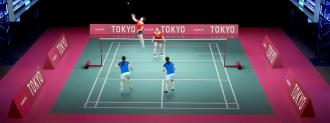A Japanese company is using holograph tech to recreate Olympic badminton matches at a venue 22 miles away from where they’re being held — in real time.
“This is the first ever holographic video transmission of a sporting event,” the telecom company writes in a press release.
The challenge: It’s hard to match the excitement of watching sports live, but for a myriad of reasons — transportation, ticket costs, a global pandemic, etc. — fans often have no choice but to enjoy games remotely, usually on a flat TV screen.
That can not only take away some of the excitement of viewing, but it also limits what fans can see to whatever the camera people decide to film.
Fans at the museum have the same view as people watching the game in person.
The holograph tech: The pandemic has put strict limits on the number of people allowed to attend events at the ongoing Tokyo Olympics, meaning remote viewing has been a bigger part of the action than usual.
In an attempt to narrow the gap between live and remote experiences, Nippon Telegraph and Telephone Corporation (NTT) is using a holograph technology called “Kirari!” to recreate Olympic badminton games in real-time at the Miraikan, a science museum on the other side of Tokyo.
“[Kirari!] aims to provide a highly realistic experience of watching competitive sport, as if the players were actually playing in front of the spectators,” the company said.
How it works: Cameras around Musashino Forest Sport Plaza record the badminton matches as they take place. NTT’s technology then extracts the footage of the players and the badminton shuttles from the video.
Those elements are then sent to the museum where a combination of mirrors and projection tech is used to recreate them as holographs on a court. People in the stands then see the same action on the museum’s court as fans watching the game in person.
Looking ahead: NTT demoed its holograph tech at SXSW 2017, projecting a musical performance from Tokyo to Austin. The fast pace of a badminton match would likely be a greater challenge, so it’ll be interesting to see whether the tech can meet it.
Even if the demo goes well, though, it’ll likely be some time before Kirari! is regularly improving the remote viewing experience for sports fans — NTT is still working to make its holograph tech cost efficient, executive research engineer Shingo Kinoshita told Axios.
We’d love to hear from you! If you have a comment about this article or if you have a tip for a future Freethink story, please email us at [email protected].






